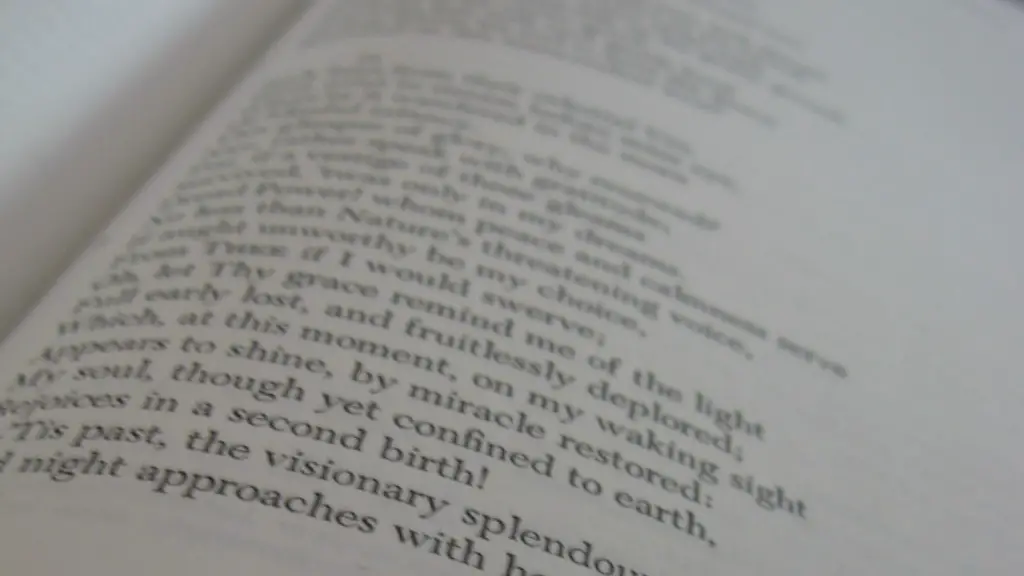How to Find Theme in Poetry
Finding the theme in poetry can be challenging and daunting task. It requires an in-depth analysis of the poem in order to determine its subject and the main idea the poet is attempting to communicate. The first step to finding the theme of a poem is to consider its structure. To do so, it is important to look at the poem’s stanzas or lines – analyzing the rhythm, the use of specific words or phrases and determining a pattern.
It is essential to focus on what the poem is saying and pay careful attention to imagery, language and tone. For example, is the poem dark and solemn? Is there an element of surprise or humor? These elements can help to uncover the theme. The use of metaphor and simile can also be indicative of the poet’s message. Metaphors and similes make comparisons and can be used to further explain the meaning of the poem.
Another important consideration is to look at the underlying message conveyed by the poet. Look for words or phrases that convey emotions such as longing, happiness, loss or regret. Thinking about the poem from a visceral perspective and understanding the emotion being expressed can help to understand the theme. It is also important to look at the poem as a whole rather than each section or stanza separately.
Once a writer has taken the time to consider the above-mentioned elements and analyze the poem, they may be able to distinguish the main idea or theme of a poem. The theme of a poem is generally a reflection of the human experience. It can range from themes of love to hate, from life and death, from joy and sadness, from nature to technology and from the passage of time. What is important to note is that the theme of the poem may not always be obvious at first glance, and an in-depth analysis of the poem is essential in order to determine it.
Exploring Meaning in Poetry
Exploring meaning in poetry also requires a certain level of analysis and interpretation. It is important to pay attention to the poet’s use of imagery, tone and language. By doing so, it is possible to uncover the hidden message or meaning behind a poem. Along with considering the visual elements of a poem, consider its underlying message and what emotions it conveys. Words such as disbelief, sorrow, love and anger are all indicative of a specific emotion the poet is conveying.
It is also important to consider the metaphor and simile used by the poet. By doing so, it is possible to gain a deeper understanding of the meaning behind the poem. Metaphors and similes are used to make comparison and can be used to further explain the hidden theme or message of a poem. It is important to remember that poetry does not always have a straightforward meaning and interpretation, and readers must be willing to explore the possible interpretations of a poem.
Taking the time to explore the poem’s imagery and its hidden message is key to uncovering the theme. Focus on what the poet is attempting to communicate and consider how the elements of the poem come together to reveal the poet’s message. With careful analysis and interpretation, it is possible to uncover the true meaning of a poem and the theme it conveys.
Analysis of Poetry
Analyzing a poem requires readers to dig deeper and pay close attention to the structure of the poem, the use of imagery, metaphor or simile and the underlying meaning or emotion behind the poem. Consider the poet’s use of language and words and how they come together to communicate a specific message. Think about the title of the poem – as titles can serve as a hint as to the poem’s hidden message or if there is a lack of a title, think about what the poem might have been titled.
By exploring all these elements, it is possible to uncover the true meaning behind a poem and understand the artist’s message. Different interpretations of a poem are possible, so it is important to consider these interpretations and what they each mean. Analysis of a poem will require readers to take the time to understand its hidden message and uncover the theme of the poem.
Understanding the Poet’s Perspective
Understanding a poet’s perspective is an essential part of interpreting the theme of a poem. Pay close attention to the poet’s use of language and how they have depicted the poem. Take the time to understand the reason behind a poet expressing certain emotions, paying special attention to the words used by them. Consider the poet’s life and any social or political movements which may have influenced the poem.
Exploring the poet’s perspective can also help to uncover the theme of a poem, as understanding their particular point of view makes it easier to find the hidden message. The influence of the poet and their life can be an essential part of unpacking the poem’s theme and understanding its message.
Connecting to Poetry
Connecting to poetry is essential to uncovering its hidden themes. Read through the poem and think about how it makes you feel. Put yourself in the poet’s shoes and think about how their life and experiences could have contributed to the poem. Ask yourself what emotions the poem makes you feel and what you can learn from it. Take the time to explore the poem’s imagery and symbolism and consider how different elements of the poem fit together.
By connecting to a poem, readers can gain a better understanding of the themes and emotions the poet is attempting to communicate. Connecting to the emotions and thoughts of the poet can bring a deeper understanding of the poem and its message. Taking the time to explore the poem can lead to uncovering the poem’s true theme.
Interpretation of Poetry
Interpretation of a poem requires readers to delve deeper and consider the poet’s use of language, imagery and symbolism. It is important to read the poem multiple times and focus on its underlying message. Take note of the poem’s structure and analyze any figurative language used by the poet. Consider the emotions the poem evokes and think about how these emotions can contribute to the poem’s understanding.
In order to interpret a poem correctly, it is important to consider the poet’s perspective and the emotions the poem conveys. Think about the poem’s main idea and theme, and how the poem links to real-life situations or experiences. Doing this can help readers to gain a better understanding of the poem and the message it attempts to share.
Uncovering the Poem’s Message
Uncovering the hidden message behind a poem requires readers to take the time to analyze its language, structure and meaning. Consider the imagery and tone of the poem, and how these elements link to the poem’s underlying message. Think of the emotions the poem evokes and how these link to the poet’s message. Take time to consider the poet’s perspective and how the poem applies to real life situations. By doing this, readers can uncover the poem’s hidden message and gain a deeper understanding of its intended theme.
Pay attention to the use of metaphor and simile in the poem and explore the possible meanings behind them. Look for words which evoke emotion and use them as clues to uncovering the poem’s hidden theme. Remember that each poem is different and that some may require more in-depth analysis and interpretation in order to understand its message.




